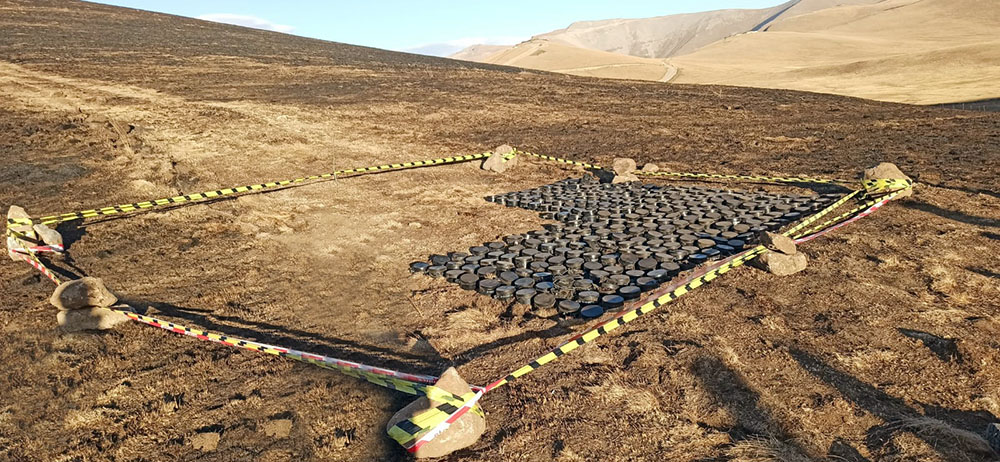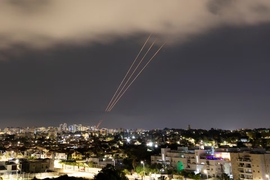The engineering and sapper units of the Azerbaijani army continue to neutralize landmines planted by the Armenian military in territories and supply routes where the Azerbaijan Armed Forces are positioned.
From September 24-25, a total of 370 anti-personnel mines of PMN-E type and 9 anti-tank mines of TM-62 type were discovered and neutralized in the territory of Alagollar, located in the Kalbajar region, as well as other areas.
Earlier, more than 310 Armenian-made landmines have been found in the Lachin and Khojaly regions of Azerbaijan. The E-001 M type devices unearthed in Lachin are equipped with remote electrical detonators for distant operation.
The explosives, manufactured in Armenia last year, were said to be buried by the Armenian saboteurs who infiltrated Azerbaijani borders on September 12 and 13.
The Armenian Armed Forces committed large-scale provocations on the state border in mid-September. The intensive shelling of the Azerbaijani positions was accompanied by the deployment of saboteurs who mined the territories and supply routes between the units of the Azerbaijani army in the Lachin, Kalbajar and Dashkasan districts.
According to the Defense Ministry, countermeasures taken by the Azerbaijani army resulted in the manpower and combat equipment losses of the Armenian armed forces involved in offensive and sabotage operations. The Armed Forces of Azerbaijan also destroyed cannons, military trucks with ammunition, a military unit, and the S-300 air defense systems of the Armenian military as a result of the retaliatory measures.
In the meantime, 80 servicemen of the Azerbaijani army were killed and 282 were wounded while suppressing the offensive of the Armenian military.
Armenia resumed its armed border provocations on September 14 when the country's armed forces deployed howitzers and mortars to shell Azerbaijan army units stationed in the directions of Kalbajar and Lachin. The Azerbaijani troops responded to the offensive with retaliatory measures. According to Azerbaijani media reports, the main purpose of the attack on September 14 was to capture Azerbaijani military positions. However, they retreated and suffered manpower losses.
The Karabakh (Garabagh) and East Zangazur regions of Azerbaijan had been heavily mined since the 1990s. Armenia launched a full-blown military assault against Azerbaijan following the Soviet Union’s dissolution in 1991. The bloody war lasted until a ceasefire was reached in 1994, which resulted in Armenia occupying 20 percent of Azerbaijan’s internationally-recognized territories. Over 30,000 Azerbaijanis were killed and one million others were expelled from those lands in a brutal ethnic cleansing campaign carried out by Armenia.
On September 27, 2020, the decades-old conflict between the two countries reignited after Armenia’s forces deployed in occupied Azerbaijani lands shelled military positions and civilian settlements of Azerbaijan. During the counter-attack operations that lasted 44 days, Azerbaijani forces liberated over 300 settlements, including the cities of Jabrayil, Fuzuli, Zangilan, Gubadli, and Shusha, from the Armenian occupation. The war ended in a tripartite statement signed on November 10, 2020, by Armenia, Azerbaijan, and Russia, under which Armenia also returned the occupied Aghdam, Kalbajar, and Lachin districts to Azerbaijan.
Since the end of hostilities, the Azerbaijani government has been carrying out demining operations in the liberated territories to expedite the return of internally displaced people to their homes.
Despite extensive efforts, demining operations faced many challenges due to Armenia’s refusal to hand over maps of the landmines’ locations. More than 240 Azerbaijani residents have been killed or wounded in the mine blasts in the liberated lands post-2020 war.
Azerbaijan obtained from Armenia the minefield maps of the once occupied Aghdam, Fuzuli and Zangilan districts, which reportedly identify the coordinates of a total of 189,000 anti-tank and anti-personnel mines. Armenia also provided the Azerbaijani side with mine maps of other liberated territories of Azerbaijan. In exchange for maps, Azerbaijan released dozens of Armenian saboteurs detained in Azerbaijani territory after the ceasefire. However, Azerbaijan’s President Ilham Aliyev said the accuracy of these maps did not exceed 25 percent. Officials in Baku are convinced that the maps hidden by Armenia could help neutralize at least one million landmines planted in the once occupied Azerbaijani lands.
According to the most recent data, in August, 2022, specialists of the Azerbaijan National Agency for Mine Action (ANAMA) found and defused 2,353 anti-personnel, 689 anti-tank mines and 1,161 unexploded ordnances.
In the meantime, President Ilham Aliyev reiterated the position of Azerbaijan regarding regional peace and the measures aimed at achieving it after decades of instability due to Armenia’s occupation of Azerbaijani lands for nearly thirty years.
“Of course, peace in our region is necessary for all countries and all peoples. Our agenda is quite unequivocal. We have repeatedly stated that we are in favor of long-term and sustainable peace, the solution of all problems related to our neighbors, and the recovery of this region from the difficult situation it was in for 30 years,” President Aliyev said in a meeting with the Russian State Duma Speaker Vyacheslav Volodin in Baku on Monday.







 The number of evacuees from flooded areas in Kazakhstan has reached 97,852 people, including about 32,856 children since March 27.
The number of evacuees from flooded areas in Kazakhstan has reached 97,852 people, including about 32,856 children since March 27.
 The Islamic holy month of fasting, Ramadan comes to an end this week with the celebration of a joyous festival called Eid (meaning “festival” in Ar...
The Islamic holy month of fasting, Ramadan comes to an end this week with the celebration of a joyous festival called Eid (meaning “festival” in Ar...
 Iran's senior military leaders described the drone and missile attack on Israel on April 14 night as “successful".
Iran's senior military leaders described the drone and missile attack on Israel on April 14 night as “successful".
 Iranian President Ebrahim Raisi warned Israel that it would face a "real and extensive" response if it makes any "mistake" following Tehran’s missi...
Iranian President Ebrahim Raisi warned Israel that it would face a "real and extensive" response if it makes any "mistake" following Tehran’s missi...



